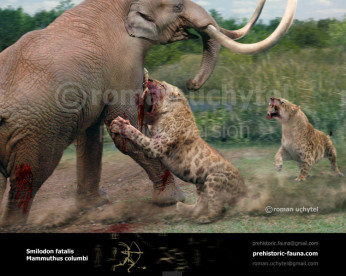La Brea Tar Pits (Pleistocene)
1000000005310000000053
La Brea Tar Pits are a group of tar pits around which Hancock Park was formed in urban Los Angeles. Natural asphalt has seeped up from the ground in this area for tens of thousands of years. The tar is often covered with dust, leaves, or water. Over many centuries, the tar preserved the bones of trapped animals. La Brea Tar Pits is a registered National Natural Landmark.
Among the prehistoric species associated with the La Brea Tar Pits are Pleistocene mammoths, dire wolves, short-faced bears, American lions, ground sloths, the saber-toothed cat (Smilodon fatalis).
The park is known for producing myriad mammal fossils dating from the last glacial period. While mammal fossils generate significant interest, other fossils, including fossilized insects and plants, and even pollen grains, are also valued. These fossils help define a picture of what is thought to have been a cooler, moister climate in the Los Angeles basin during the glacial age. Among these fossils are microfossils, which are retrieved from a matrix of asphalt and sandy clay by washing with a solvent to remove the petroleum, then picking through the remains under a high-powered lens.
Tar pits around the world are unusual in accumulating more predators than prey. The reason for this is unknown, but one theory is that a large prey animal would die or become stuck in a tar pit, attracting predators across long distances. This predator trap would catch predators along with their prey. Another theory is that dire wolves and their prey may have been trapped during a hunt. Since modern wolves hunt in packs, each prey animal could take several wolves with it. The same may be true of saber-toothed cats known from the area.
Payment
You may use multiple payment methods to buy image such as credit cards, PayPal and bank transfer.
La Brea Tar Pits are a group of tar pits around which Hancock Park was formed in urban Los Angeles. Natural asphalt has seeped up from the ground in this area for tens of thousands of years. The tar is often covered with dust, leaves, or water. Over many centuries, the tar preserved the bones of trapped animals. La Brea Tar Pits is a registered National Natural Landmark.
Among the prehistoric species associated with the La Brea Tar Pits are Pleistocene mammoths, dire wolves, short-faced bears, American lions, ground sloths, the saber-toothed cat (Smilodon fatalis).
The park is known for producing myriad mammal fossils dating from the last glacial period. While mammal fossils generate significant interest, other fossils, including fossilized insects and plants, and even pollen grains, are also valued. These fossils help define a picture of what is thought to have been a cooler, moister climate in the Los Angeles basin during the glacial age. Among these fossils are microfossils, which are retrieved from a matrix of asphalt and sandy clay by washing with a solvent to remove the petroleum, then picking through the remains under a high-powered lens.
Tar pits around the world are unusual in accumulating more predators than prey. The reason for this is unknown, but one theory is that a large prey animal would die or become stuck in a tar pit, attracting predators across long distances. This predator trap would catch predators along with their prey. Another theory is that dire wolves and their prey may have been trapped during a hunt. Since modern wolves hunt in packs, each prey animal could take several wolves with it. The same may be true of saber-toothed cats known from the area.

-797x638.jpg)
-346x277.jpg)
1-346x277.jpg)
